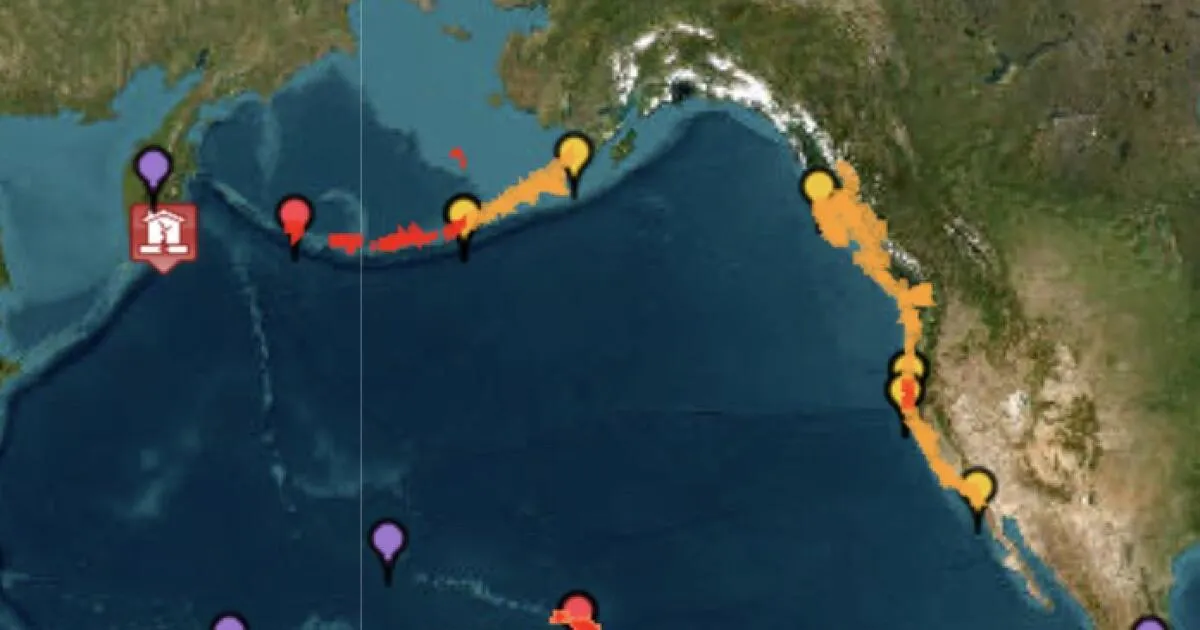
Officials have issued a more severe tsunami warning for California’s North Coast, specifically in Humboldt and Del Norte counties. Crescent City, known as a historical tsunami hot spot, is anticipated to experience the worst potential damage from this event. The tsunami warning represents the highest level in the U.S. Tsunami Warning Center's three-tier alert system, which includes watch, advisory, and warning. Residents in the affected areas are strongly urged to evacuate immediately away from the coast.
A tsunami warning is also in effect across all of Hawaii, prompting residents to move inland quickly. Additional warnings have been issued in Guam and along the western Aleutian Islands of Alaska. The remainder of the California coastline remains under a tsunami advisory, indicating that dangerous waves and strong currents are anticipated, and individuals should avoid the beaches.
Should a tsunami materialize in California, the first waves are expected to strike the North Coast at approximately 11:50 p.m. local time, with the Los Angeles area bracing for impact by 1 a.m. The predicted impact in Los Angeles is expected to be minimal, with waves measuring less than 1 foot. However, in Crescent City, waves could reach heights of up to 4.8 feet, and the tsunami may persist for as long as 30 hours.
Crescent City has a tragic history with tsunamis; the harbor was devastated, and one man lost his life during the 2011 tsunami resulting from a 9.1 magnitude earthquake in Japan. Port San Luis in San Luis Obispo County is also identified as a potential area for significant tsunami activity, with waves expected to reach between 2 to 3.7 feet. For the rest of California's coast, waves of 1.3 feet or less are predicted.
The tsunami alerts were triggered on Tuesday afternoon following an 8.8 magnitude earthquake that struck off the eastern coast of Russia. This seismic event sent powerful waves crashing into buildings in Siberia and northeastern Japan. The earthquake occurred at 9:25 a.m. Wednesday local Russian time—equivalent to 4:25 p.m. Tuesday PDT—resulting in strong tremors that injured several individuals, according to reports by Reuters.
A tsunami measuring between 10 to 13 feet impacted the Kamchatka Peninsula in Siberia within hours of the earthquake, damaging structures, including a kindergarten. Japanese officials have advised residents to evacuate from tsunami-prone areas along the east coast, anticipating waves of up to 10 feet. In Hawaii, residents are facing congested roadways as they heed evacuation orders. Some individuals have been observed stocking up on supplies at local stores in preparation for the tsunami, which could arrive as early as 7:17 p.m. local time, or 10:17 p.m. PDT.
In light of the tsunami warnings, Southwest Airlines rerouted a flight from Los Angeles International Airport (LAX) to Honolulu, returning to LAX due to safety concerns. Local resident Dominga Advincula expressed her anxiety, stating, “Right now, we’re traumatized,” referencing the previous disasters the community has faced. She noted that sirens signaling evacuation have caused distress among residents still recovering from past events.
Initial reports indicate that the first tsunami wave may not necessarily be the largest. Historical data shows that tsunamis can last for several hours, with the most devastating waves sometimes arriving after smaller ones. The 1964 tsunami that hit Crescent City serves as a grim reminder, as residents were caught off-guard by subsequent, larger waves after a series of smaller surges. Officials warn that even seemingly small waves can be dangerously destructive.
According to the National Tsunami Hazard Mitigation Program, as little as six inches of fast-moving water can knock over an adult, while two feet can sweep away most vehicles. L.A. Mayor Karen Bass has been in contact with coastal leaders and the Port of Los Angeles to ensure overnight preparations are in place. She urged residents to sign up for emergency alerts at NotifyLA.org to stay informed and safe during this critical time.